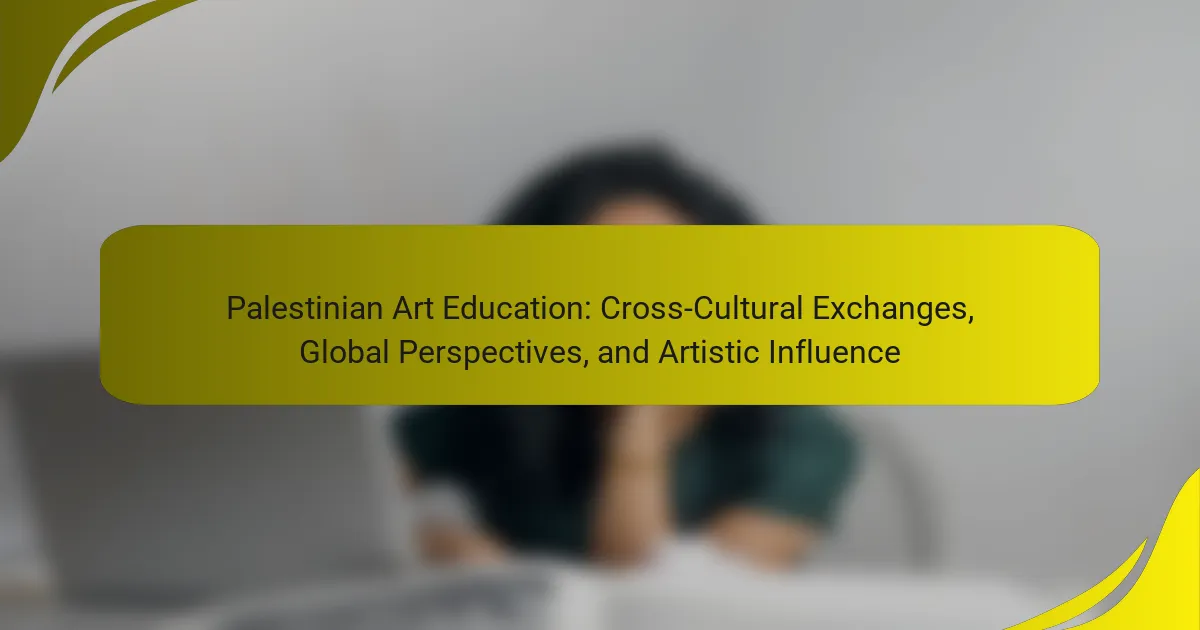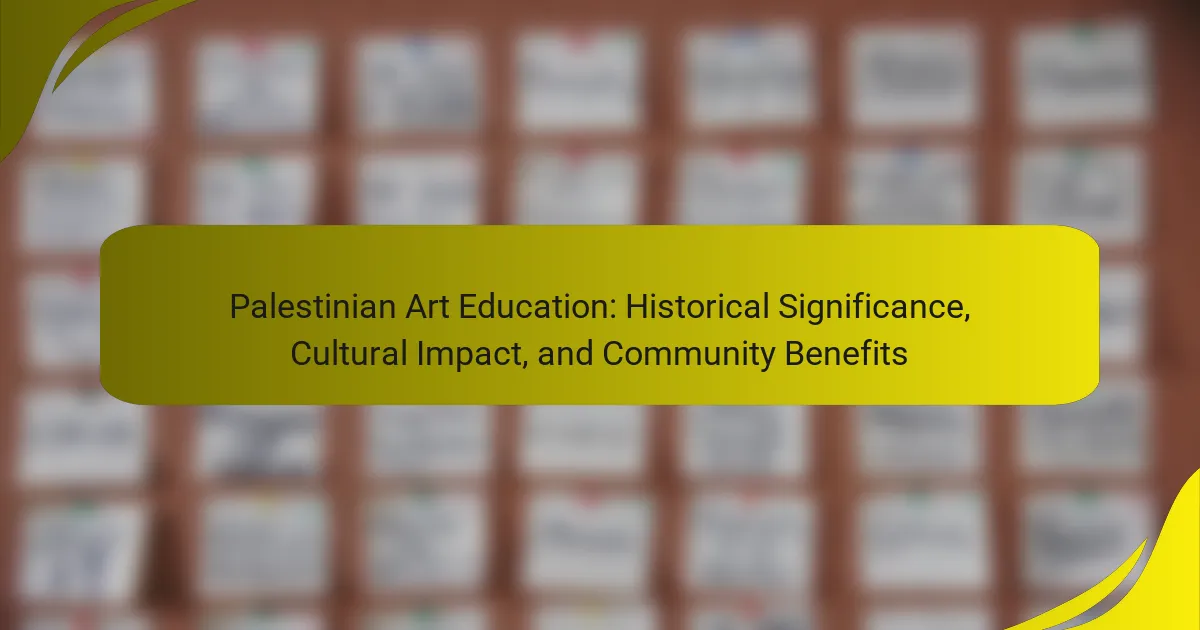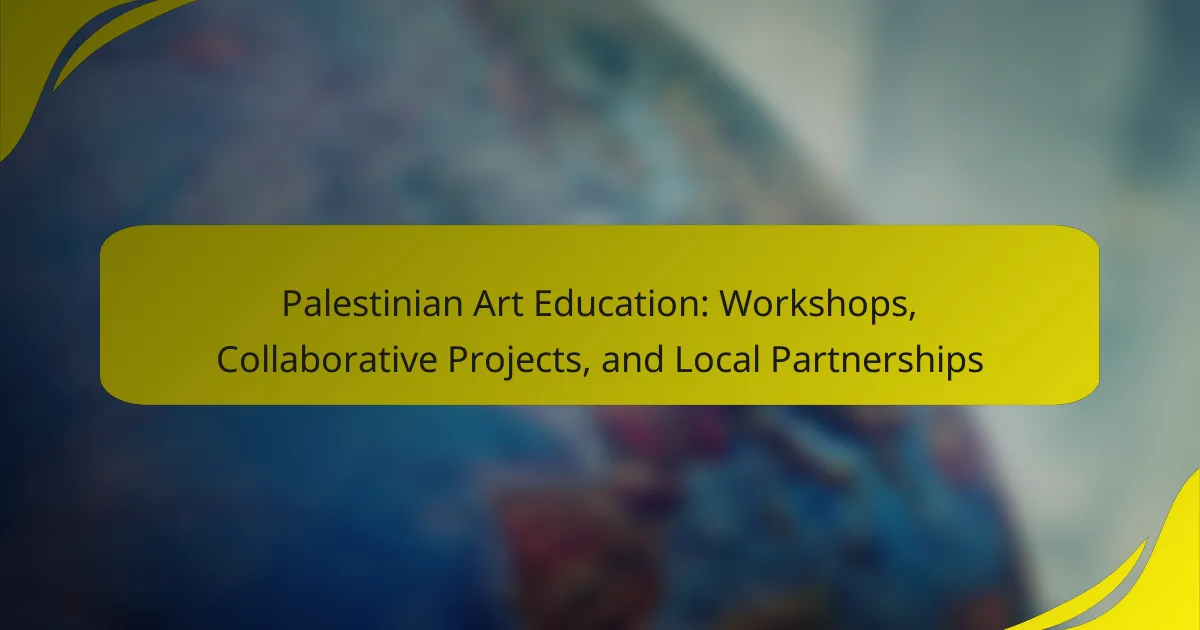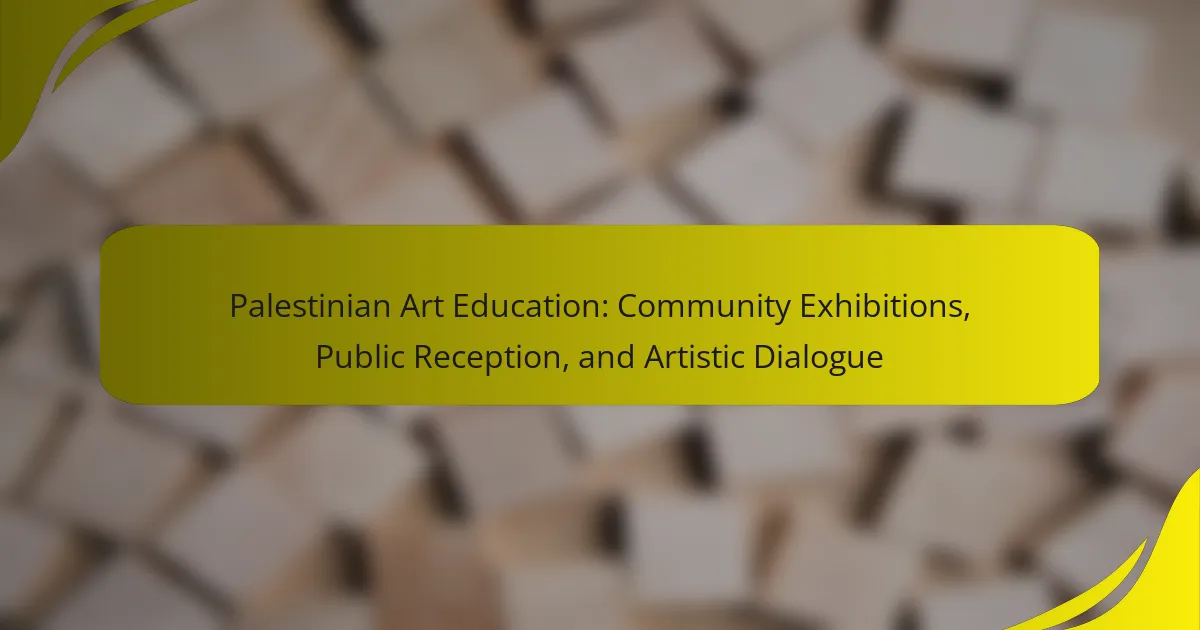Palestinian Art Education focuses on the structured teaching of artistic practices within Palestinian communities, covering visual arts such as painting, sculpture, and multimedia. This educational framework aims to enhance creativity, technical skills, cultural awareness, and critical thinking among students, while integrating elements of Palestinian heritage and social issues. Institutions provide mentorship and professional development opportunities for emerging artists, fostering community engagement and preserving cultural narratives through art. Career pathways for Palestinian artists include fine arts, graphic design, art education, and art therapy, with a growing emphasis on digital art and online sales, reflecting the diverse talents within the art community.
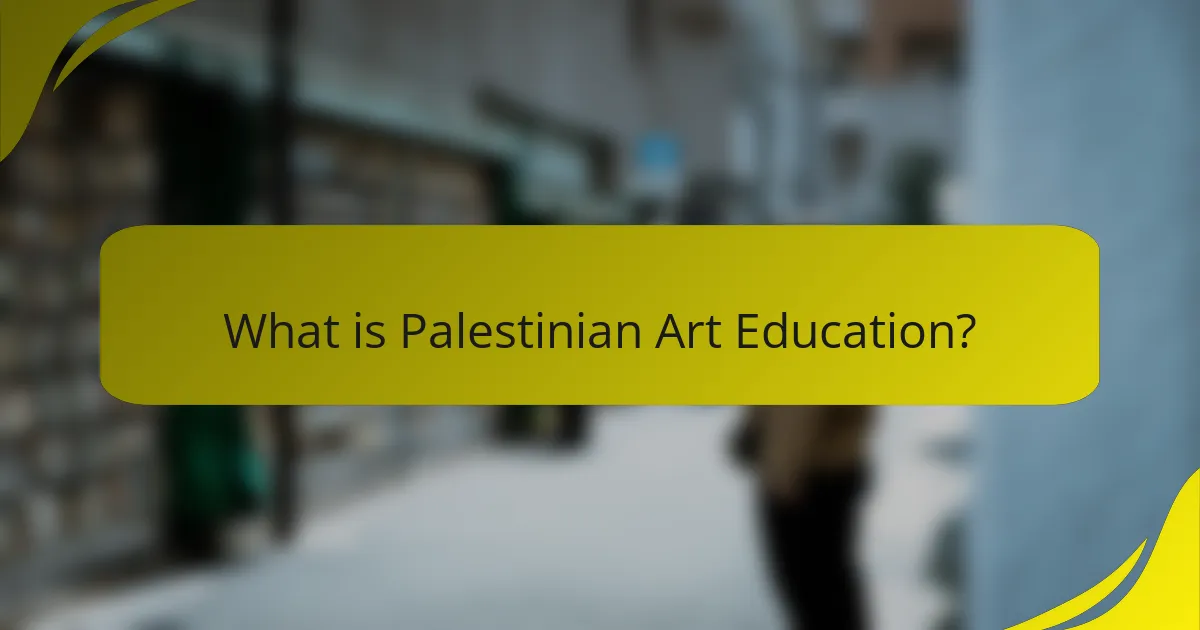
What is Palestinian Art Education?
Palestinian Art Education refers to the structured teaching and learning of artistic practices within Palestinian communities. It encompasses various forms of visual arts, including painting, sculpture, and multimedia. This education aims to cultivate creativity and artistic skills among students. It often integrates cultural heritage and social issues relevant to Palestinian identity. Institutions and programs provide mentorship opportunities for emerging artists. These initiatives help develop professional pathways in the art field. Art education in Palestine also fosters community engagement and expression. It plays a crucial role in preserving cultural narratives through artistic expression.
How does Palestinian Art Education differ from other art education systems?
Palestinian Art Education differs from other art education systems primarily through its integration of cultural identity and political context. It emphasizes the expression of Palestinian heritage and experiences. This education system often incorporates themes of resistance and resilience in its curriculum. Furthermore, it promotes community engagement and social activism through art.
The mentorship aspect is crucial, as experienced artists guide younger generations in navigating both artistic and socio-political landscapes. Skill development is tailored to address local needs and challenges, which may not be present in other systems. Additionally, Palestinian art education often faces unique constraints due to political instability, influencing teaching methods and resource availability.
These factors collectively create a distinct approach to art education that is deeply rooted in the Palestinian experience.
What cultural influences shape Palestinian Art Education?
Palestinian Art Education is shaped by a variety of cultural influences. The historical context of Palestine plays a significant role. The ongoing conflict has fostered a sense of identity and resilience among artists. Traditional Palestinian crafts, such as embroidery and pottery, influence contemporary art practices. The integration of folklore and oral traditions enriches artistic expression. Additionally, the diaspora community contributes diverse perspectives and techniques. Educational institutions often incorporate these cultural elements into their curricula. The interplay of local and global art movements also impacts Palestinian art education.
How is Palestinian Art Education structured?
Palestinian Art Education is structured through various formal and informal institutions. These include universities, community centers, and art schools. Curriculum often integrates traditional and contemporary art practices. Mentorship plays a crucial role, connecting students with experienced artists. Workshops and exhibitions provide practical experience and exposure. Additionally, art education emphasizes cultural identity and social issues. This structure aims to foster creativity and professional development. In recent years, initiatives have emerged to support emerging artists in the region.
Why is mentorship important in Palestinian Art Education?
Mentorship is crucial in Palestinian Art Education because it provides guidance and support to emerging artists. This relationship fosters skill development and enhances creative expression. Experienced mentors help students navigate the unique challenges of the Palestinian context. They offer insights into art techniques and cultural significance. Mentorship also encourages networking opportunities within the art community. This connection can lead to exhibitions and collaborations. Moreover, mentors inspire confidence and resilience in young artists. Studies show that mentorship significantly improves educational outcomes in creative fields.
What roles do mentors play in the development of young artists?
Mentors play crucial roles in the development of young artists. They provide guidance and support throughout the artistic journey. Mentors help young artists refine their skills and techniques. They offer constructive feedback on artistic work. Mentors also share industry knowledge and professional practices. This information is vital for navigating the art world. Additionally, mentors can facilitate networking opportunities. These connections can lead to exhibitions and collaborations. Research indicates that mentorship significantly enhances artistic growth and career success.
How can mentorship enhance skill development in art?
Mentorship enhances skill development in art by providing personalized guidance and feedback. Mentors share their expertise and techniques, which can accelerate learning. They offer critiques that help artists refine their work. This process fosters creativity and innovation in artistic expression. Mentorship also provides networking opportunities, connecting artists with industry professionals. A study by the National Endowment for the Arts found that mentorship significantly improves artistic skills and career outcomes. Mentored artists often report increased confidence and motivation. Thus, mentorship is crucial for developing artistic skills effectively.
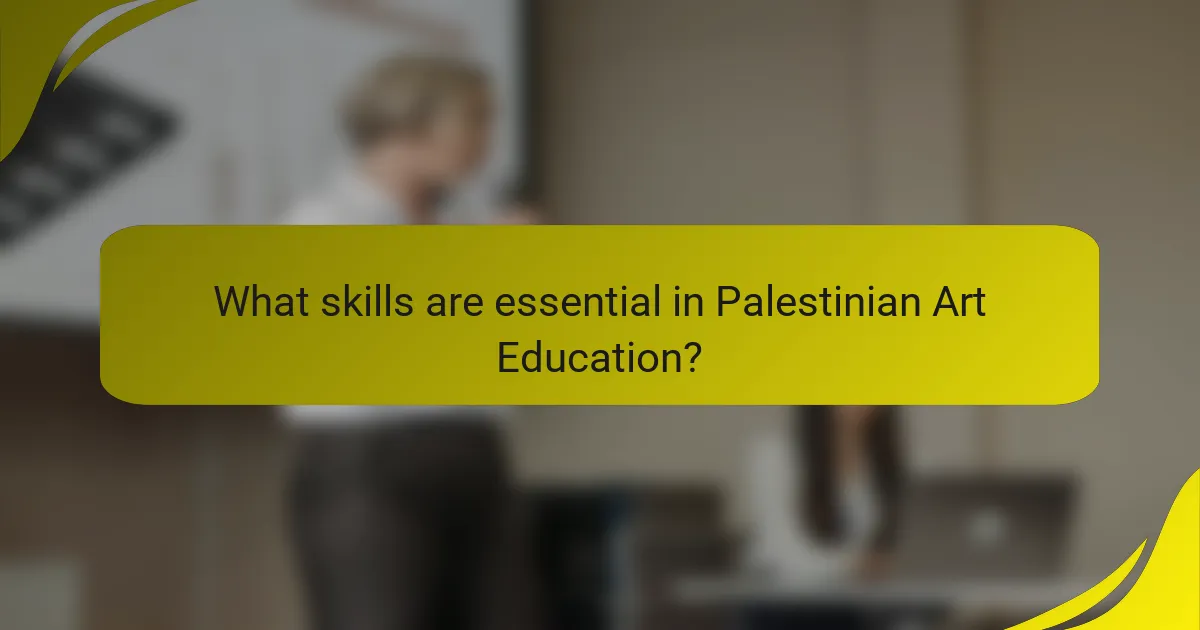
What skills are essential in Palestinian Art Education?
Essential skills in Palestinian Art Education include creativity, technical proficiency, cultural awareness, and critical thinking. Creativity allows students to express their unique perspectives and emotions through art. Technical proficiency encompasses skills in various mediums, such as painting, sculpture, and digital art. Cultural awareness is crucial for understanding and representing Palestinian heritage and identity in artistic expressions. Critical thinking enables students to analyze their work and the work of others, fostering deeper engagement with art concepts. These skills are vital for nurturing a vibrant art community and for the personal development of artists within the Palestinian context.
How are technical skills taught in Palestinian Art Education?
Technical skills in Palestinian Art Education are taught through hands-on workshops and mentorship programs. These programs emphasize practical experience in various artistic techniques. Students learn from established artists who share their expertise. Curriculum often includes drawing, painting, sculpture, and digital art. Collaborative projects foster teamwork and peer learning. Art institutions also provide access to necessary tools and materials. This approach enhances both technical proficiency and creative expression. Evidence of this method can be seen in successful local artists who attribute their skills to these educational frameworks.
What specific techniques are emphasized in the curriculum?
The curriculum emphasizes techniques such as drawing, painting, and sculpture. These techniques are foundational for developing artistic skills. Additionally, students learn digital art and graphic design. These modern techniques enhance creativity and technical proficiency. Workshops and hands-on projects reinforce these skills. Mentorship plays a critical role in guiding students through these techniques. Artists provide feedback and support during the learning process. This approach fosters both skill development and personal expression.
How do traditional and contemporary practices intersect in skill development?
Traditional and contemporary practices intersect in skill development by blending historical techniques with modern methodologies. Traditional practices often emphasize foundational skills and cultural heritage. These practices provide a framework for understanding artistic expressions and techniques. Contemporary practices introduce innovative tools and technologies. They encourage experimentation and adaptability in art-making. This intersection fosters a holistic approach to skill development. For example, artists may learn traditional painting methods while also utilizing digital platforms. This combination enhances creativity and broadens career opportunities in the art field. The integration of both practices prepares artists for diverse challenges in their careers.
What soft skills are cultivated through Palestinian Art Education?
Palestinian Art Education cultivates various soft skills. These include creativity, communication, and critical thinking. Creativity is developed through artistic expression and exploration. Communication skills are enhanced through collaboration and presentation of artwork. Critical thinking is fostered by analyzing art and making informed decisions. Additionally, teamwork skills are strengthened during group projects. Problem-solving abilities are also improved when artists face challenges in their work. Empathy and cultural awareness are cultivated through engagement with diverse perspectives. These soft skills are essential for personal and professional growth in various fields.
How do communication and collaboration play a role in art education?
Communication and collaboration are essential components of art education. They facilitate the exchange of ideas among students and instructors. Effective communication enhances understanding of artistic concepts. Collaboration encourages teamwork, leading to diverse creative outcomes. In art education, working together fosters a supportive learning environment. This environment promotes peer feedback and shared learning experiences. Studies show that collaborative projects improve artistic skills and confidence. For example, group exhibitions allow students to showcase their work collectively. This not only builds community but also enhances individual artistic expression.
Why is critical thinking important for aspiring artists?
Critical thinking is essential for aspiring artists because it enhances their ability to analyze and interpret their work. This skill allows artists to evaluate their creative choices and understand the context of their art. Critical thinking fosters innovation by encouraging artists to question norms and explore new ideas. It also aids in problem-solving, enabling artists to overcome challenges in their creative process. Research shows that artists who engage in critical thinking produce more meaningful and impactful work. For example, a study by the National Endowment for the Arts highlights that critical thinking contributes to artistic growth and professional development. Thus, aspiring artists benefit greatly from cultivating critical thinking skills.
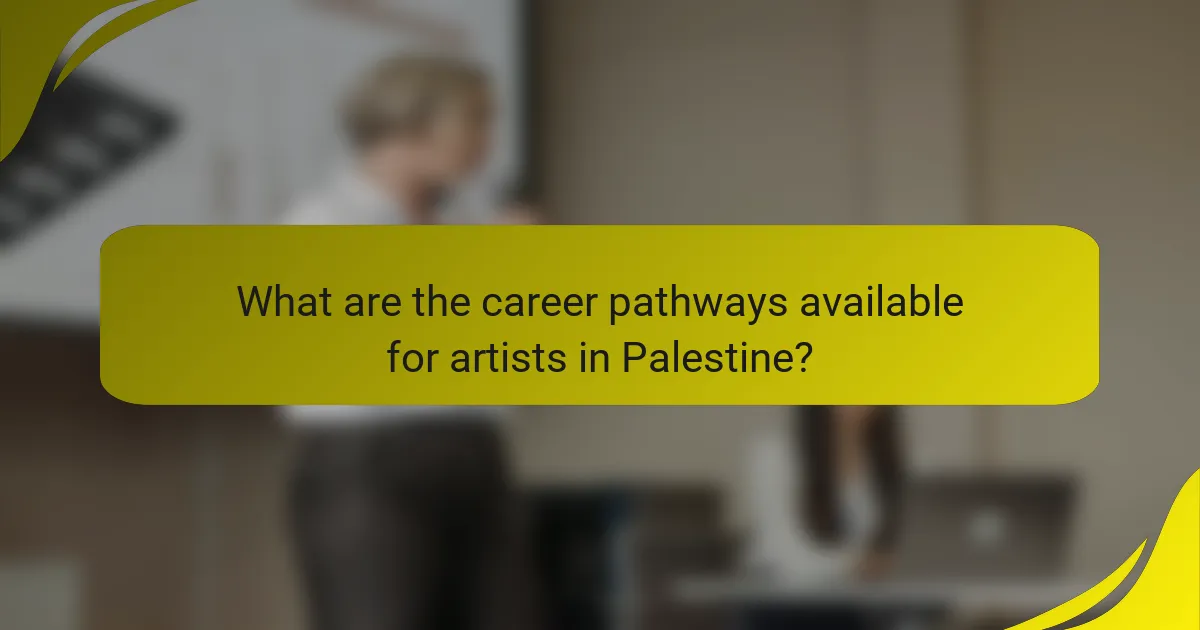
What are the career pathways available for artists in Palestine?
Artists in Palestine can pursue various career pathways. These include fine arts, graphic design, and illustration. Many artists engage in community art projects and cultural initiatives. Others may find opportunities in art education, teaching in schools or workshops. Some artists work in the field of art therapy, using art to support mental health. Additionally, there are opportunities in art curation and museum work. Freelancing is also common, allowing artists to sell their work independently. The growing digital landscape offers avenues in digital art and online sales. These pathways reflect the diverse talents and skills within the Palestinian art community.
How does Palestinian Art Education prepare students for professional careers?
Palestinian Art Education prepares students for professional careers by providing essential skills and mentorship. It emphasizes practical training in various artistic disciplines. Students learn techniques in painting, sculpture, and digital media. The curriculum often includes real-world projects and collaborations with local artists. This hands-on experience enhances their portfolios. Mentorship programs connect students with established professionals. These connections can lead to internships and job opportunities. Additionally, art education fosters critical thinking and creativity, which are valuable in many careers. Overall, Palestinian Art Education equips students with both technical skills and industry insights.
What types of careers can graduates pursue in the art field?
Graduates in the art field can pursue various careers, including fine artist, graphic designer, and art educator. Fine artists create original works for exhibitions and sales. Graphic designers develop visual content for digital and print media. Art educators teach art techniques and history in schools or community programs. Other career options include art therapy, where professionals use art to support mental health. Additionally, graduates can work in art curation, managing collections in galleries or museums. The art field also offers opportunities in illustration, animation, and art direction in advertising. Each of these careers requires a unique set of skills and education, often gained through formal art programs.
How can networking enhance career opportunities for young artists?
Networking enhances career opportunities for young artists by providing access to valuable connections and resources. It allows artists to meet industry professionals, potential collaborators, and mentors. These relationships can lead to job opportunities, exhibitions, and commissions. Networking also facilitates knowledge sharing and skill development through workshops and events. According to a study by the National Endowment for the Arts, artists who engage in networking report higher career satisfaction and success. Additionally, networking helps artists build a supportive community, which is crucial for artistic growth and resilience.
What challenges do artists face in their career pathways?
Artists face several challenges in their career pathways. Limited access to resources is a significant issue. Many artists struggle to find funding for their projects. This lack of financial support can hinder artistic development. Additionally, networking opportunities are often scarce. Artists may find it difficult to connect with mentors or industry professionals. This isolation can impede career growth. Furthermore, market saturation poses a challenge. Many artists compete for the same audience or gallery space. This competition can make it hard for individual artists to stand out. Lastly, cultural and political factors can impact artistic expression. In regions like Palestine, artists may face restrictions that affect their work. These challenges collectively create a complex landscape for artists navigating their careers.
What barriers exist in the Palestinian art market?
The Palestinian art market faces several barriers that hinder its growth and accessibility. Limited funding restricts artists from pursuing projects and exhibitions. Political instability creates an uncertain environment for art transactions. Restrictions on movement affect artists’ ability to showcase their work internationally. Lack of institutional support limits opportunities for professional development. Additionally, there is a scarcity of art galleries and platforms for exposure. Cultural perceptions may undervalue contemporary art, impacting sales. These barriers collectively stifle artistic expression and economic viability within the market.
How can mentorship help overcome these challenges?
Mentorship can help overcome challenges in Palestinian art education by providing guidance and support. Mentors can share their expertise and experiences, helping mentees navigate obstacles. This relationship fosters skill development through personalized feedback and encouragement. Mentorship also opens networking opportunities, connecting artists with industry professionals. Research indicates that mentorship can enhance career pathways, leading to increased job placements. A study by the National Mentoring Partnership shows that mentored individuals are 55% more likely to enroll in college and 78% more likely to hold leadership positions. Thus, mentorship plays a crucial role in addressing the challenges faced in Palestinian art education.
What best practices can enhance Palestinian Art Education?
Integrating community engagement is a best practice to enhance Palestinian Art Education. This approach fosters collaboration between artists and local communities. It encourages students to express their cultural identity through art. Providing access to diverse art forms enriches the educational experience. Establishing mentorship programs connects students with experienced artists. This guidance helps develop technical skills and career pathways. Incorporating technology in art education broadens access to resources. Online platforms can facilitate virtual workshops and exhibitions. Lastly, promoting interdisciplinary approaches can inspire creativity and innovation in students.
How can institutions improve mentorship programs?
Institutions can improve mentorship programs by implementing structured frameworks and regular evaluations. A structured framework includes defined goals, expectations, and timelines for both mentors and mentees. Regular evaluations help assess the effectiveness of the mentorship and identify areas for improvement. Institutions should also provide training for mentors to enhance their skills. Research indicates that trained mentors lead to more successful outcomes for mentees. Additionally, fostering a culture of feedback encourages open communication between mentors and mentees. This approach has been shown to increase engagement and satisfaction in mentorship relationships. Finally, offering diverse mentorship opportunities can cater to various needs of mentees, enhancing their overall experience.
What strategies can be implemented for better skill development?
Effective strategies for better skill development include mentorship programs, hands-on workshops, and collaborative projects. Mentorship provides guidance and personalized feedback from experienced artists. Workshops offer practical experience and exposure to various techniques. Collaborative projects encourage teamwork and the sharing of diverse ideas. Research indicates that mentorship significantly enhances skill acquisition and confidence. A study by the National Endowment for the Arts found that mentorship programs improve artistic skills and career outcomes. Engaging with the community through exhibitions and critiques also fosters growth. Continuous practice and self-assessment are vital for skill refinement.
Palestinian Art Education is a structured approach to teaching artistic practices in Palestinian communities, focusing on visual arts such as painting, sculpture, and multimedia. The article explores the unique aspects of this education system, highlighting the integration of cultural identity, mentorship, and community engagement, which are crucial for skill development and professional pathways for emerging artists. It addresses the specific challenges faced by artists in Palestine, including limited resources and political constraints, while emphasizing the importance of mentorship in overcoming these obstacles. Additionally, the article outlines essential skills cultivated through Palestinian Art Education, including creativity, technical proficiency, and critical thinking, and discusses various career opportunities available to graduates in the art field.
